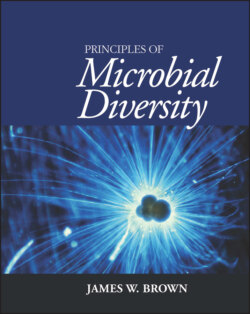Читать книгу Principles of Microbial Diversity - James W. Brown - Страница 20
Behavioral diversity
ОглавлениеIt may seem odd to consider the behavior of microscopic organisms, but they do have behavior. Motility and taxis are one form of behavior, both of which come in a variety of forms, from the phototactic Chlorobium bacteria that use gas vacuoles and symbiosis with motile bacteria to adjust their place in the water column (Fig. 1.6) to the chemotactic Rhizobium bacteria that sense and swim (via flagella) toward chemical signals sent by receptive plant roots. Magnetotactic bacteria have a built-in magnetic compass that allows them to use Earth’s magnetic field for orientation.
Figure 1.6 Chlorobium symbiotic consortium. (Reprinted from Wanner G, Vogl K, Overmann J, J Bacteriol 190:3721–3730, 2008, with permission.) doi:10.1128/9781555818517.ch9.f9.10
All organisms have developmental cycles; at the very least they can switch between active-growth (i.e., log phase) to resting or slow-growth (i.e., stationary phase) stages. Other developmental cycles include sporulation; the production of swarmer cells, cysts, or akinetes; and even terminal differentiation and development into distinct germ and somatic cell types, such as heterocysts in filaments of cyanobacteria, “slugs” in myxobacteria, and the very complex life cycles of Streptomyces species (Fig. 1.7).
Figure 1.7 Overlay of phase-contrast and red and green fluorescent images of sporulating Streptomyces coelicolor grown on SFM agar plates for 3 days. Red fluorescence results from the DNA stain 7-AAD; chromosomes are stained unevenly because the image was made by using live cells. Green is the fluorescence of SsfA-GFP. SsfA, a protein that is upregulated during sporulation and localizes to sporulation septa, has been fused to the green fluorescent protein GFP. Images were taken with a Zeiss fluorescence microscope and further artistically rendered with Adobe Photoshop. (Courtesy of Nora Ausmees.) doi:10.1128/9781555818517.ch1.f1.7
Microbes also respond to their environments metabolically, by expressing the genes needed to compete for the resources available at the time. An example of this would be converting metabolism from oxidative to fermentative when oxygen is exhausted in a culture or from glucose to galactose use when the glucose is used up in a mixed-sugar medium.
In addition, microbes act communally. Organisms communicate by sending and receiving chemical signals or by direct contact. For example, Myxococcus (Fig. 1.8) swarming begins with a chemical signal propagated through the community, which brings the cells into proximity. Direct contact between cells then directs aggregation and formation of fruiting bodies. Microbes also form specific symbioses with other microbes or with macroscopic creatures. Complex communities of microbes associate into “mats” that process and recycle resources throughout the community.
Figure 1.8 A swarm of Myxococcus xanthus (left) invading a colony of E. coli (right). (Reprinted from Berleman JE, Scott J, Chumley T, Kirby JR, Proc Natl Acad Sci USA 105:17127–17132, 2008. Copyright 2008 National Academy of Sciences, USA.) doi:10.1128/9781555818517.ch1.f1.8
